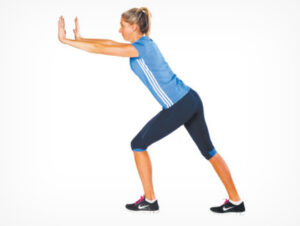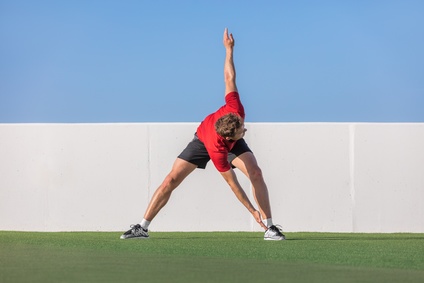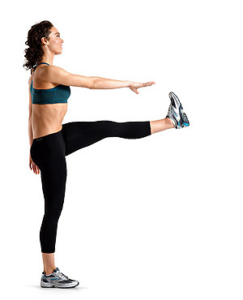We are in the middle of the running, biking, and triathlon season, which means those who participate in these are training and preparing for competition. A warm-up routine along with stretching before a race or workout is important both for injury prevention and overall performance. But what kinds of stretches are best to perform to optimize your workout? While most people are familiar with static stretching and do it often before an activity, there is sufficient evidence that points to a more dynamic stretching routine to help with better performance.
What is static stretching?
Static stretching refers to taking a muscle to its end range and holding that stretch for 15-30 seconds to feel a good “pull” or lengthening of the muscle. The goal of this is to help increase flexibility and allow the muscle to become less stiff. This is beneficial for increasing range of motion.
Here’s an example: runner’s calf stretch, leaning forward on one leg with the other leg behind you and foot on the ground to allow a pull in the back of the leg.

How is dynamic stretching different?
Dynamic stretching refers to taking the muscle through a range of motion with movement, but not holding that stretch. This allows the body to activate the muscles to do a task while taking the muscle through a functional range of motion and movement pattern, helping “wake up” the muscles before an activity.
Here’s an example: a controlled kick out with the knee straight while reaching toward the extended foot with the opposite hand (while keeping a neutral spine) to get a stretch in the hamstring without holding the position.
What do studies say about which type of stretching is better?
It is important to prepare the muscles for the demands of each sport to allow better muscle activation, improved movement, and power. A 2011 study by Perrier et al. indicates those who performed dynamic stretches vs static stretching after warm-up had increased initial countermovement jump heights and performances. This study also showed that both static and dynamic stretching was beneficial for the overall increase in range of motion as demonstrated with the sit and reach test (a test looking at hamstring flexibility).1 Another study done in 2016 by Amruta P. et al indicates that those who performed dynamic stretching after a warm-up had better power with the vertical jump compared to those who did not stretch or did static stretching after warm-up.2 Thus, while both static and dynamic stretches have their advantages and uses, these studies are indicative of improved athletic performance with dynamic stretching before an activity that requires a combination of flexibility and explosive movements. Thus, it is recommended to add dynamic stretching into your program after a warm-up to help prepare your body for your specific sport. The warm-up in these studies was 5 minutes of either light jogging on a treadmill or cycling on a bike to increase heart rate and metabolism.
The most important thing about stretching is that you do it!
It is my hope that the take home from this information is to do something before a workout! This research is pointing toward the use of dynamic stretching to help your body prepare for bursts of movements and to prepare for function and sports specific programs. This type of stretching has shown to increase power and performance and may be beneficial to add into your warm-up routine. However, if you are restricted with your functional range of motion this type of stretching may be difficult and you may need a program to help restore this movement. For more information or to learn a static and dynamic stretching program that would work for you, please contact any of our offices to set up an appointment with a therapist.
Happy summer, be safe!
References:
- Perrier, Erica T; Pavol, Michael J; Hoffman, Mark A. The Acute Effects of a Warm-Up Including Static or Dynamic Stretching on Countermovement Jump Height, Reaction Time, and Flexibility The Journal of Strength & Conditioning Research: July 2011 – Volume 25 – Issue 7 – p 1925-1931 doi: 10.1519/JSC.0b013e3181e73959 https://journals.lww.com/nsca-jscr/Fulltext/2011/07000/The_Acute_Effects_of_a_Warm_Up_Including_Static_or.19.aspx
- Amruta P. Balkawade, Deepali N. Hande Effect Of Acute Dynamic And Static Stretching On Maximal Muscular Power In Recreational Athletes IOSR Journal of Sports and Physical Education (IOSR-JSPE)e-ISSN: 2347-6737, p-ISSN: 2347-6745, Volume 3, Issue 2 (Mar. – Apr. 2016), PP 13-18 http://www.iosrjournals.org/iosr-jspe/papers/vol3-issue2/D03021318.pdf



I agree! It’s good to do some stretches or warm up exercises before getting into workout. It helps from getting sudden pressure over muscles which can avoid pain
It is very impressive and informative post. I promote this types of post where it comes to fitness first.